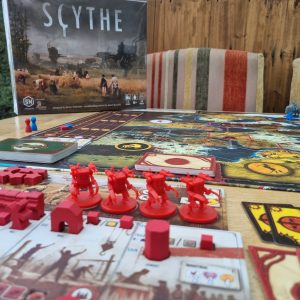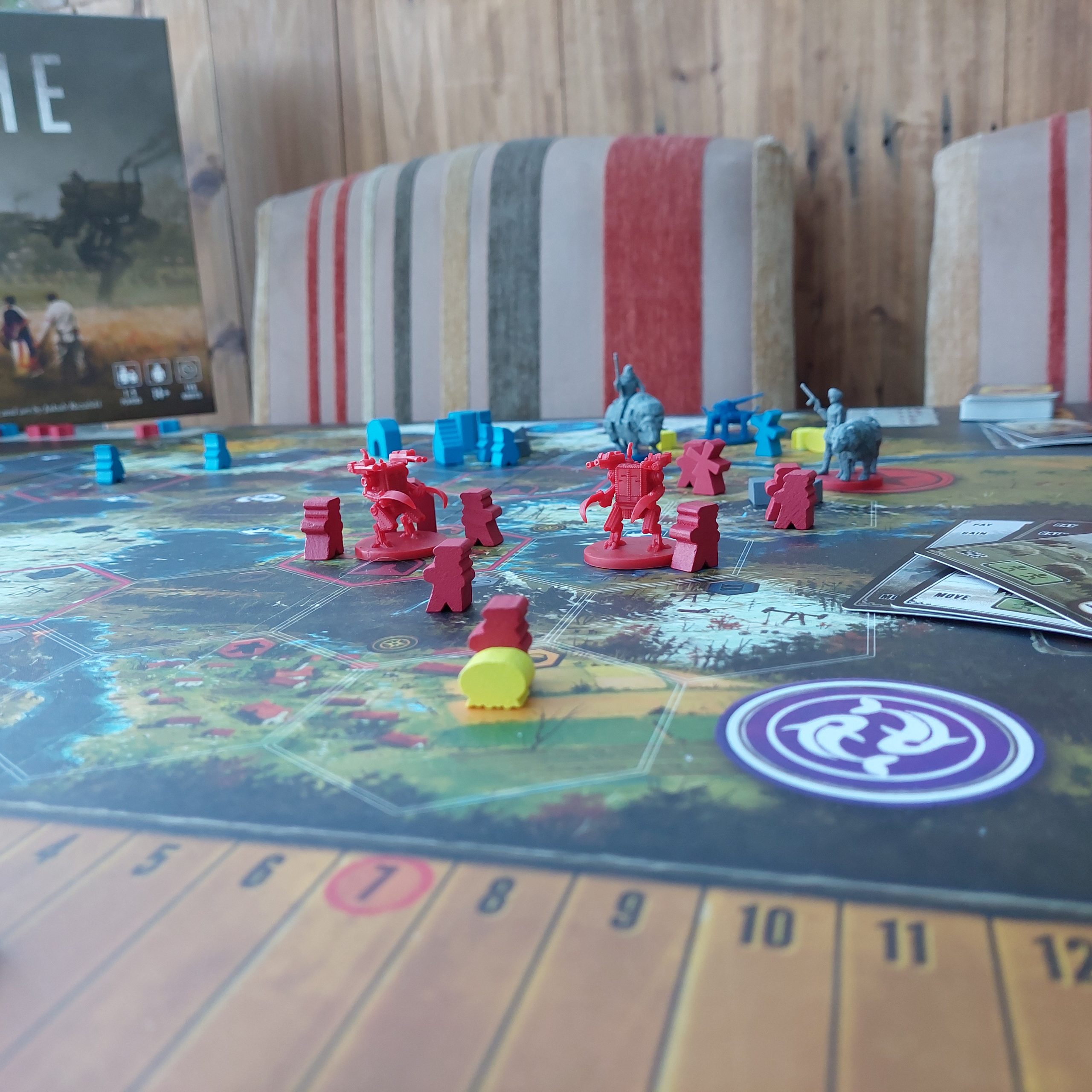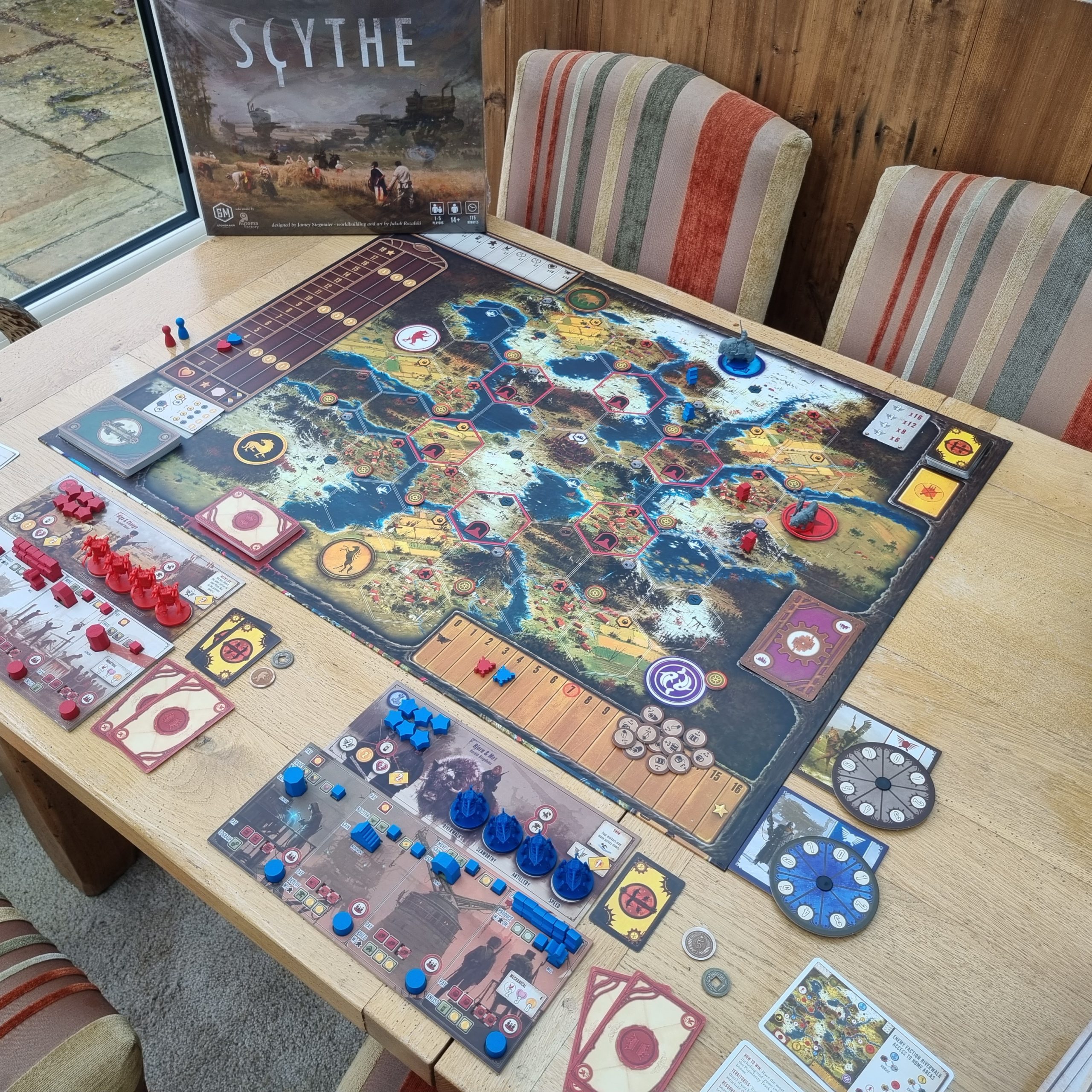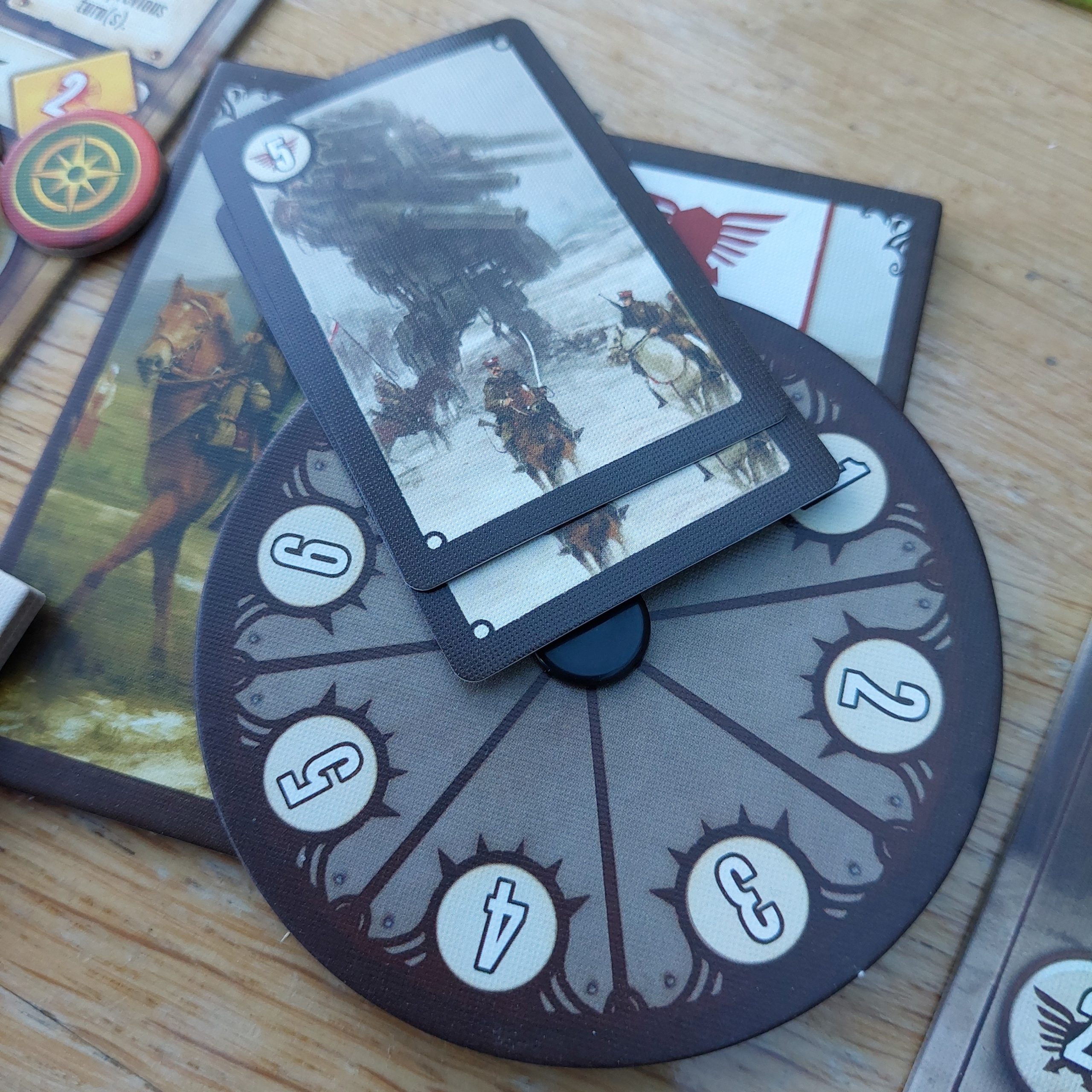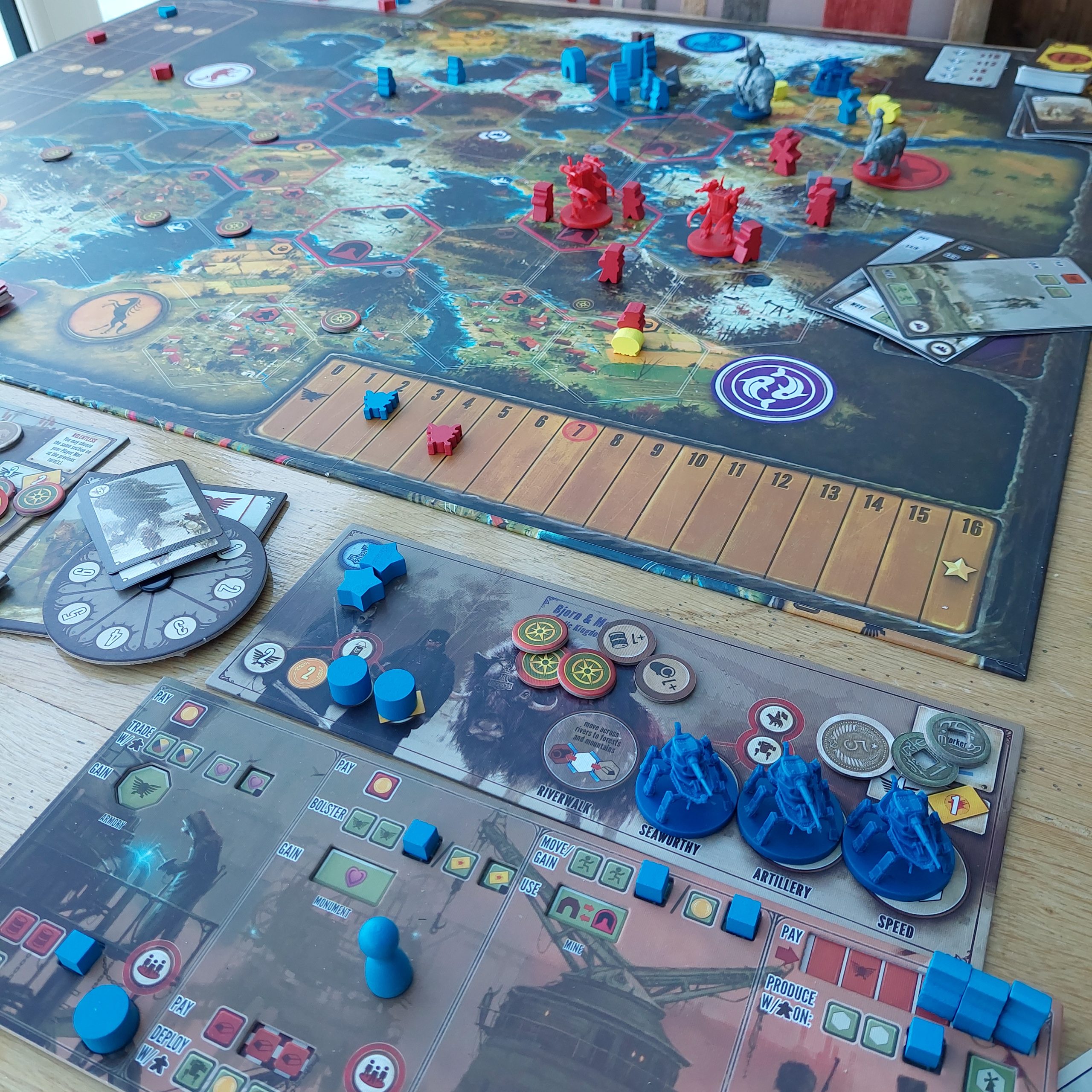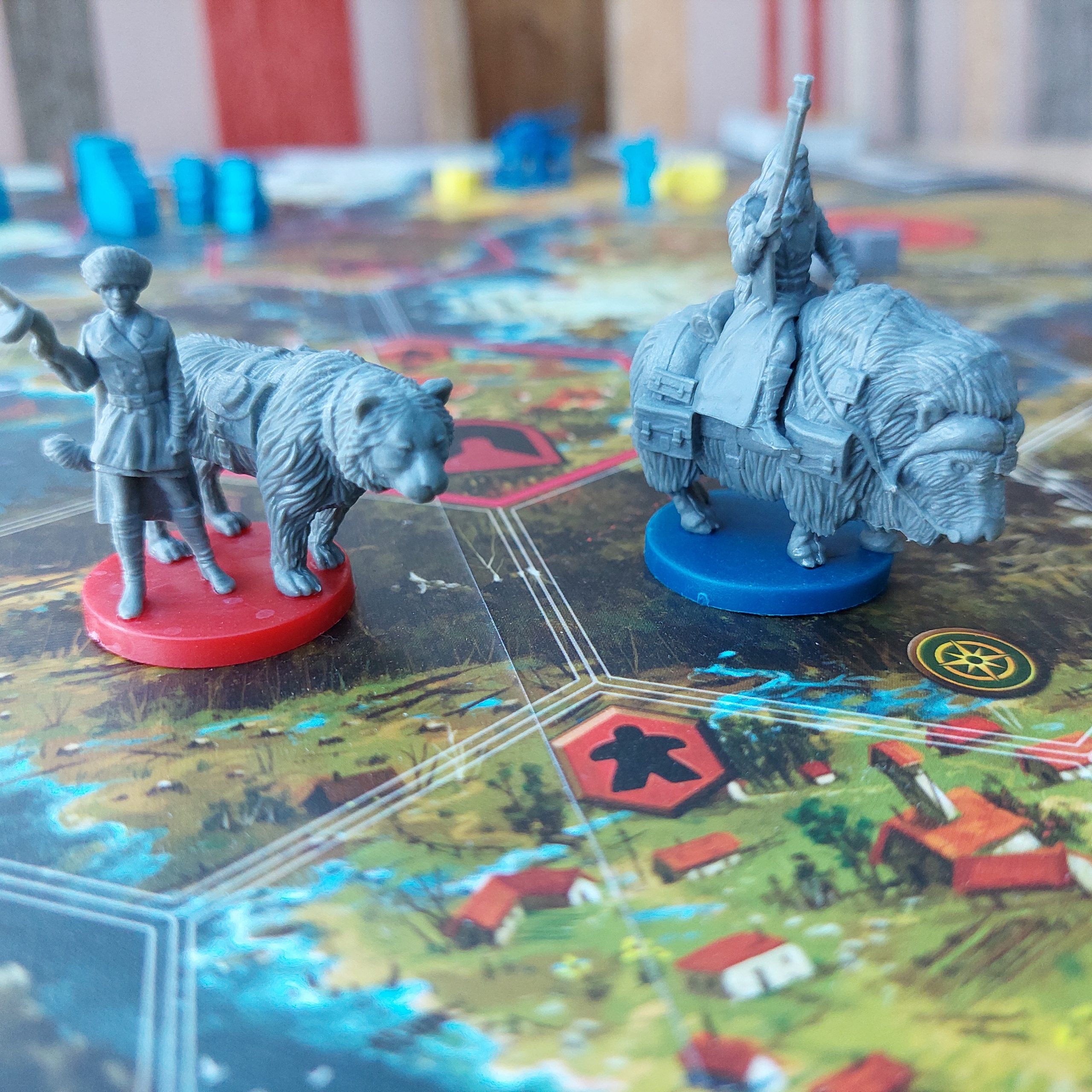We have been immersing ourselves in alt-reality 1920s Europa in the epically strategic Scythe by Jamey Stegmaier and Stonemaier Games!
Publisher: Stonemaier Games
Designer: Jamey Stegmaier
Artist: Jakub Rozalski
Release date: 2016
1-5 players
Age: 14+
90 – 120 mins
* Card Play Conflict Resolution * Contracts * End Game Bonuses * Force Commitment * Grid Movement * Hexagon Grid * King of the Hill * Movement Points * Solo / Solitaire Game * Take That * Tech Trees / Tech Tracks * Variable Player Powers * Variable Set-up * Victory Points as a Resource * Zone of Control
Scythe
Scythe.
I’m just going to leave that word there for a moment. Exactly like I did the box when it first arrived.
Why? Well, this game kind of overwhelmed me when I saw it for real. I knew about it of course. I had drifted past conversations between other gamers that were deep diving into the tactics and strategies. But I always presumed Scythe was beyond me in terms of gameplay. I didn’t feel worthy of it. Like I hadn’t earned the hobby stripes needed to do it, or myself, justice.
But as a gamer and a reviewer, I appreciate that my experience can influence others. Whether one person or lots of folks take the time to read what I write, I have the potential to make an impact. And so I wanted to try it. I wanted to find out if I could. And I was excited to share my thoughts because of the potential to help other gamers like me who, until now, might also have been too afraid to play it….
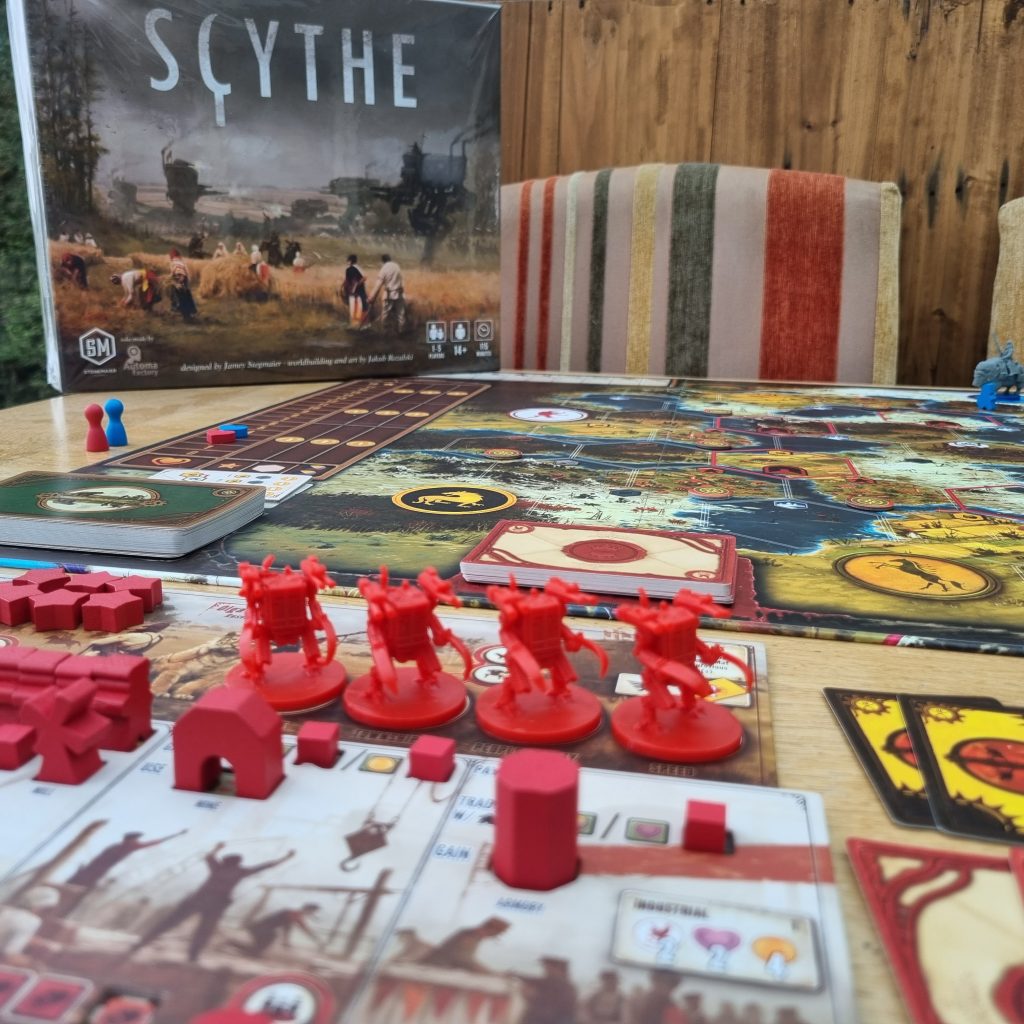
Going in!
So, I looked at the box from all angles. I picked it up (no mean feat as this one is a hefty Harry!). I put it down. I opened it. I took out the book that sat atop a very colourful board. I started to read the rules. And then I put them on the side and went to lie down!
Okay, so I didn’t take to our bed, but I couldn’t process all the information in one sitting. There seemed to be so much. So much to learn. So much to do. So many choices. Maybe it was beyond me after all.
But then I steadied myself and set up our first game. I admit fully that I didn’t (and still haven’t) taken in all the rules. But we were eager to get stuck in. So we took it slow and got to the end. I wasn’t really sure why I was doing what I was doing, or what I should have been doing. I knew I wanted to get stars and money. But not really how to gain either. Anyway, I did some stuff. My husband did some stuff too. We didn’t do it all because we didn’t understand how it all weaved together.
A few days later, still dizzy from the first bash, we played again. And sitting there, I realised that Scythe didn’t have to be an expansive hammer-blow to the head. There is a lot to take in. And you can absolutely get lost in it if you want to. And if I played that way, I would be overwhelmed by the choices and opportunities.
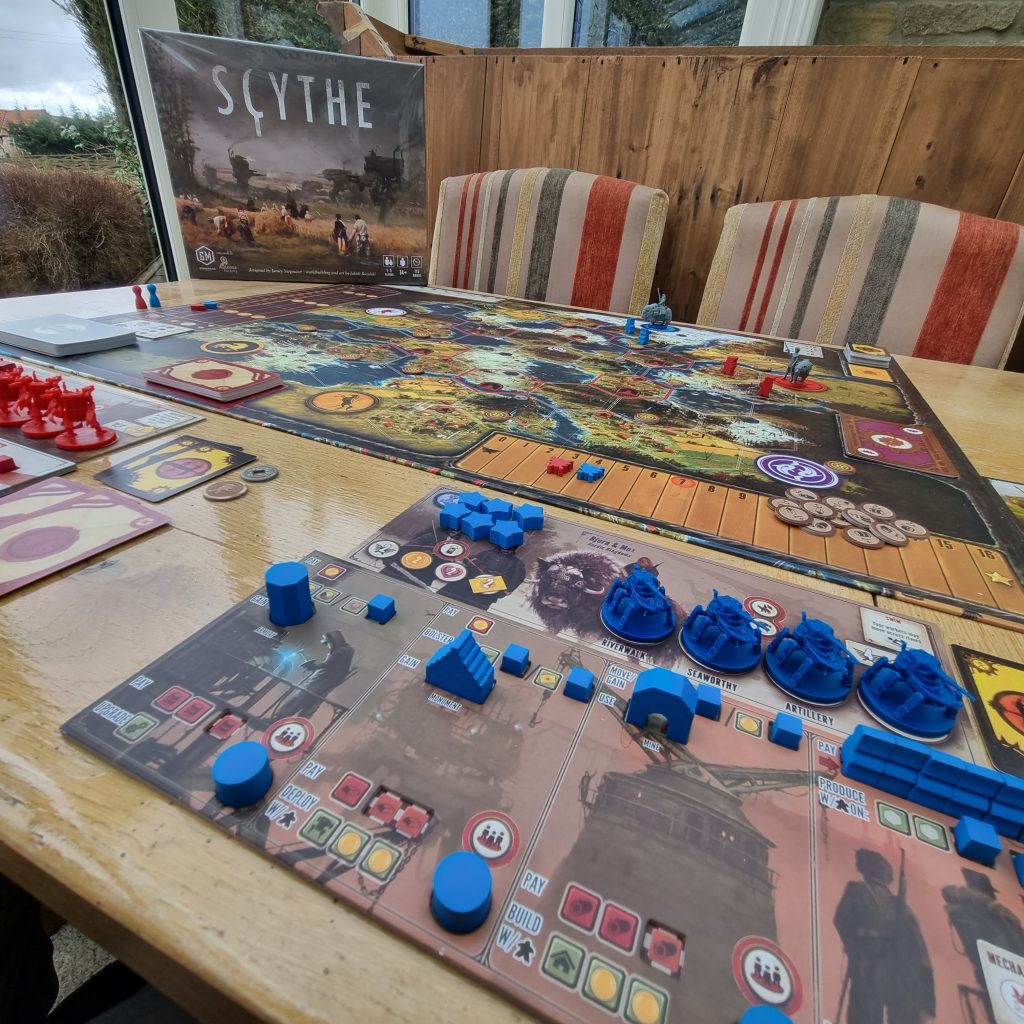
But Scythe isn’t a sand-box game where I often resort to drifting around, aimless. There’s money to be made in the race for stars. And these overarching factors means the game has momentum and an ultimate goal. it’s also not mind-bogglingly complicated either. Yes, the rules seem scary to me when there’s so much potential activity to be done. But to make it work for me, the broad-spectrum opportunities need a management plan. And by choosing what I focus on in a game of Scythe, that’s exactly what I have been creating. But more on that later.
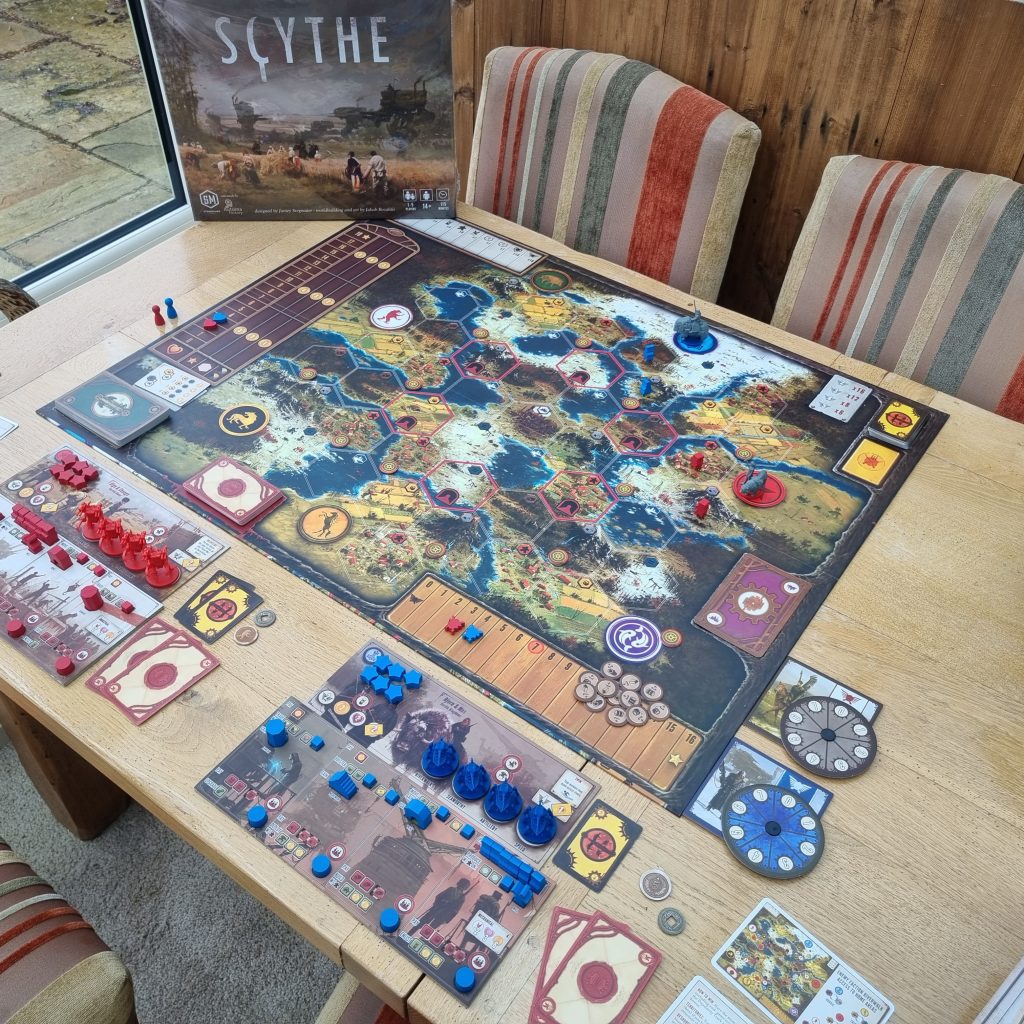
Europa Engines!
Now, If you are reading this not knowing much about the game or the background, Scythe is a design by Jamey Stegmaier and published by Stonemaier Games. It’s set in the 1920s in an alt-reality fictional post-war place called Europa. Lots of very clever folks out there can tell you whether this game rings true in terms of geo-politico-social development. But I don’t have that knowledge base for that. So I’m going to stick to what the game is, what we did in the game, and whether we enjoyed it!
Scythe is billed as an engine builder. But it’s not just one engine. It’s a whole fleet of engines, firing up and working together to propel you towards first place. Or maybe that should be potentially propelling. Because you’ve got to make the right choices to fuel the benefit machines working on securing your victory!
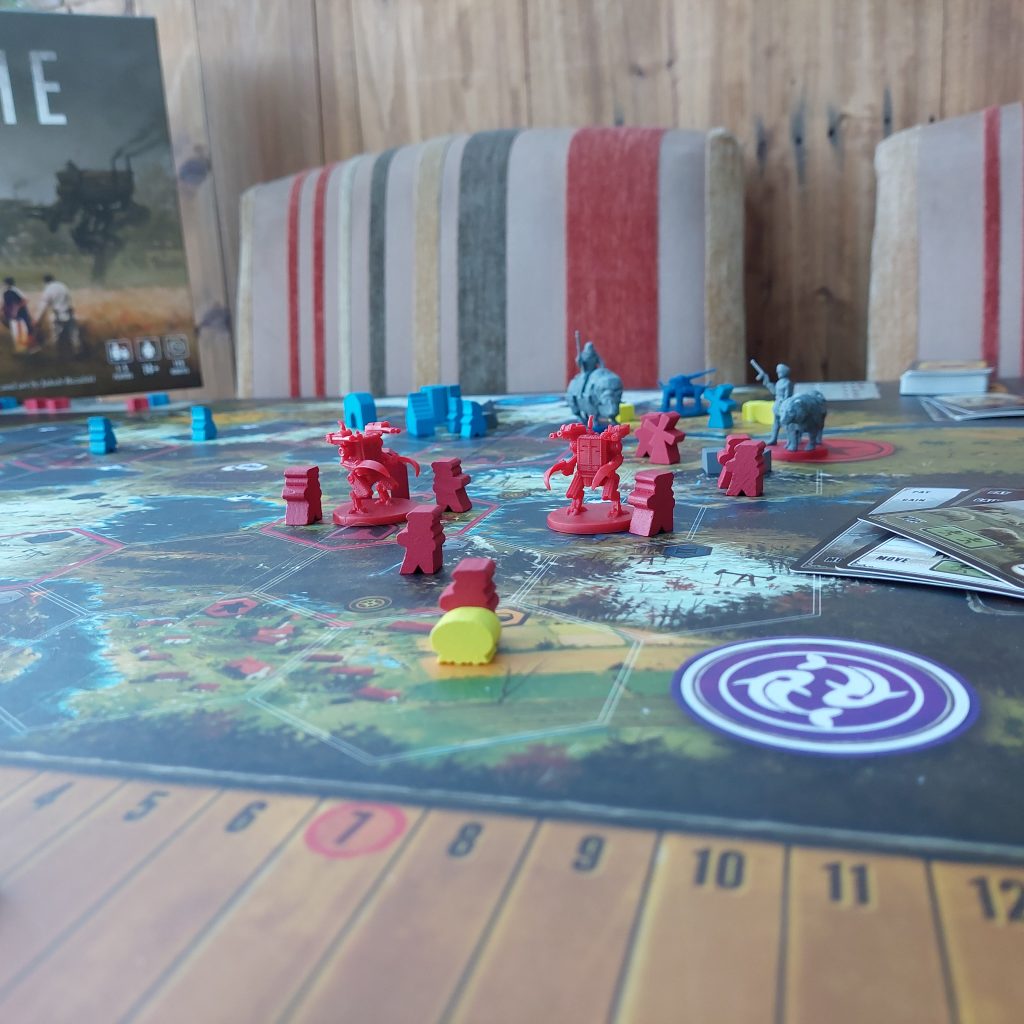
Fabulous Factions!
Each player takes on the role of the leader of a Faction that wants to lay claim to the land around the mysterious centralised factory. With everything scarce, your job is to utilise your available actions and special abilities to produce, populate, please, and punch your way to reaping the most riches by end game. The game end triggers when a player has achieved their 6th star (goal) but the true victory lies in the money made.
And, looking at the boards and the minis and the cards, that sounds like a tall order. And it is. Or rather, it would be if you did have to do all those things every game. But as I mentioned above, you don’t have to. You can’t in fact. And thanks to the asymmetric powers of your own character and your actions, you are naturally going to put your boots in certain places but not others.
Helpfully, stars can be gained from all sorts of things during a game. And so tactics can tailored to what you want to aim to achieve. Which is brilliant for a gamer like me who often has a very different skill set and approach to those of my regular opponents. I don’t do very well in one-size fits-all strategy-based games because, more often than not, I don’t fit-all.
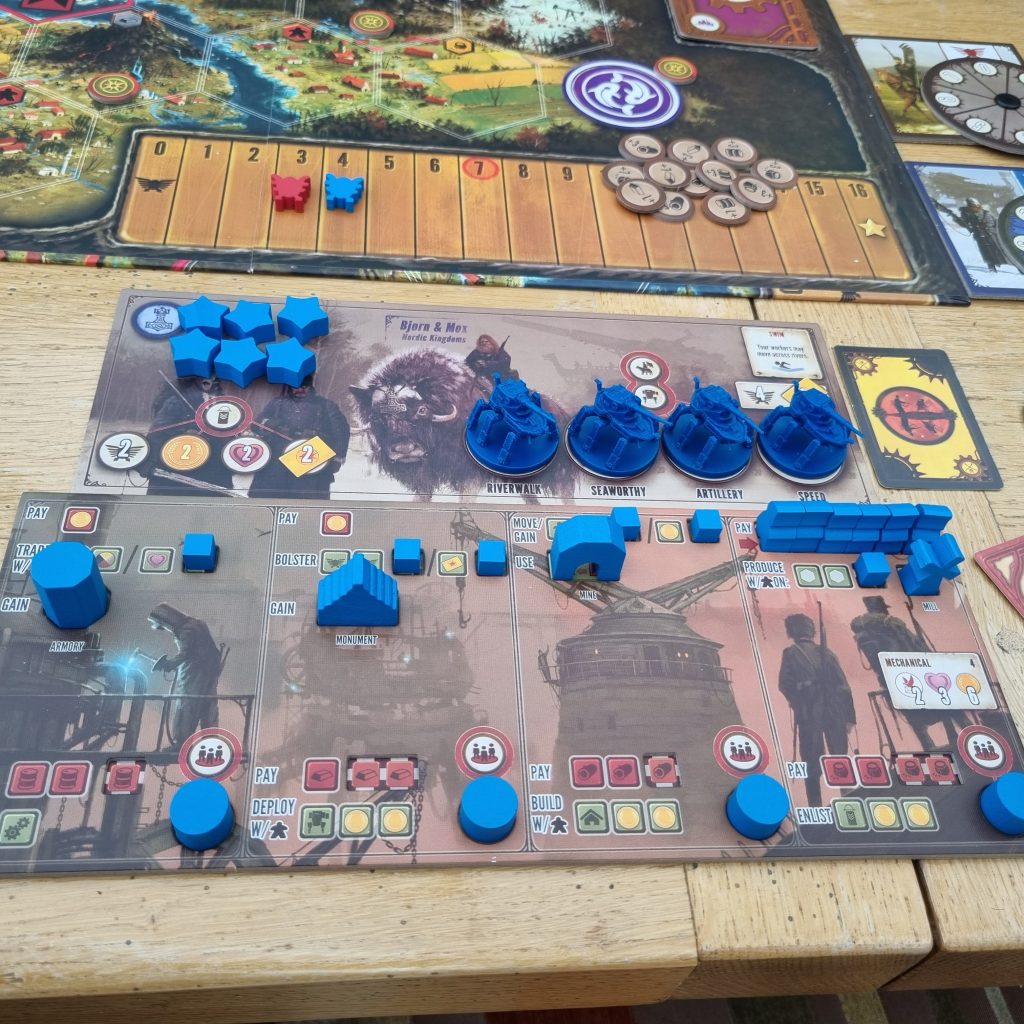
Driving Miss Scythe!
So, Scythe is a game that puts you in the driving seat of your own, unique strategy. And that’s great, isn’t it? Well yes, but it also means you have nowhere to hide from the responsibility that comes with such freedom. And, I think, unless you have a management plan that ignores some of the options, it could feel overwhelming. To support this approach, little left-to-chance happens. Reactions yes. Randomness? Besides from initial set up, not so much. And that’s because, in part, of a very clever action selection system which each player has at their disposal.
Each turn, you select from a series of individual set actions. A top action on your own player board and then, if you can afford it and want to do it, a bottom action from the same column. Importantly, the price of your actions (and later upgrades) differs to those of your opponents. But no matter which Faction you play (well all except one), you can’t do the same action twice in a row. So timing to maximise what each action is worth to you at the moment its used (or saved for later) become important factors. Further, as these actions accumulate, upgrade, and repeat, those engines I mentioned get stronger and produce more and more effects.
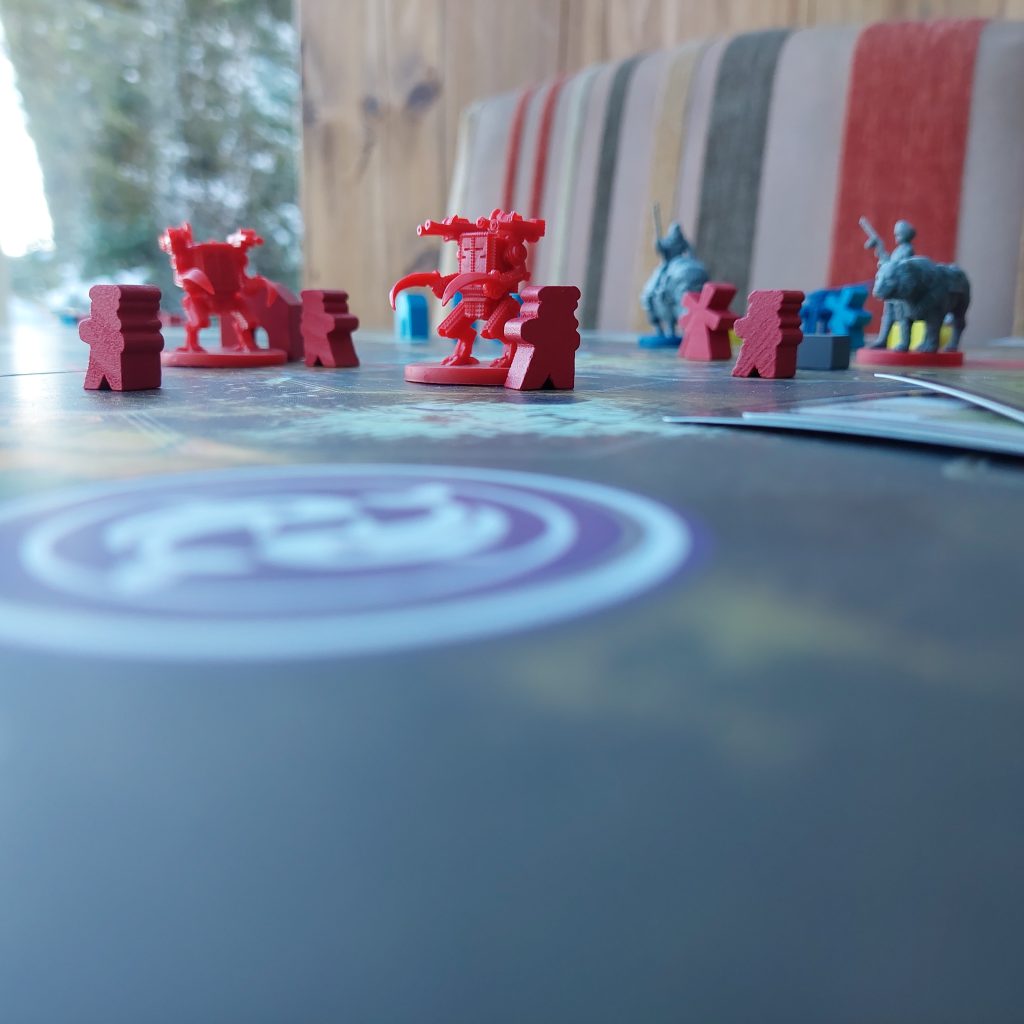
Player of the people!
And it sounds funny to say that Scythe is a popularity content. Nothing about the look of scythe suggests high school dances. But it is. The more popular you become, the more those 6 stars you are trying to achieve are worth at end game. And you can trade money for popularity during the game which helps, as does certain bonuses to be achieved.
Because, as we quickly realised money maketh the victor in Scythe! So reputation itself becomes a sort of quasi-engine to feed and reap. But, as in real-life, popularity is a fickle mistress. And it can be lost much faster than it takes to build. So what you think each of your stars might be worth at end game could prove to be very different!
Coins aren’t just for the most fan-girled over Faction though. Materials and spaces you control earn you money at end game too, so resource management and area control are also potential money spinners.
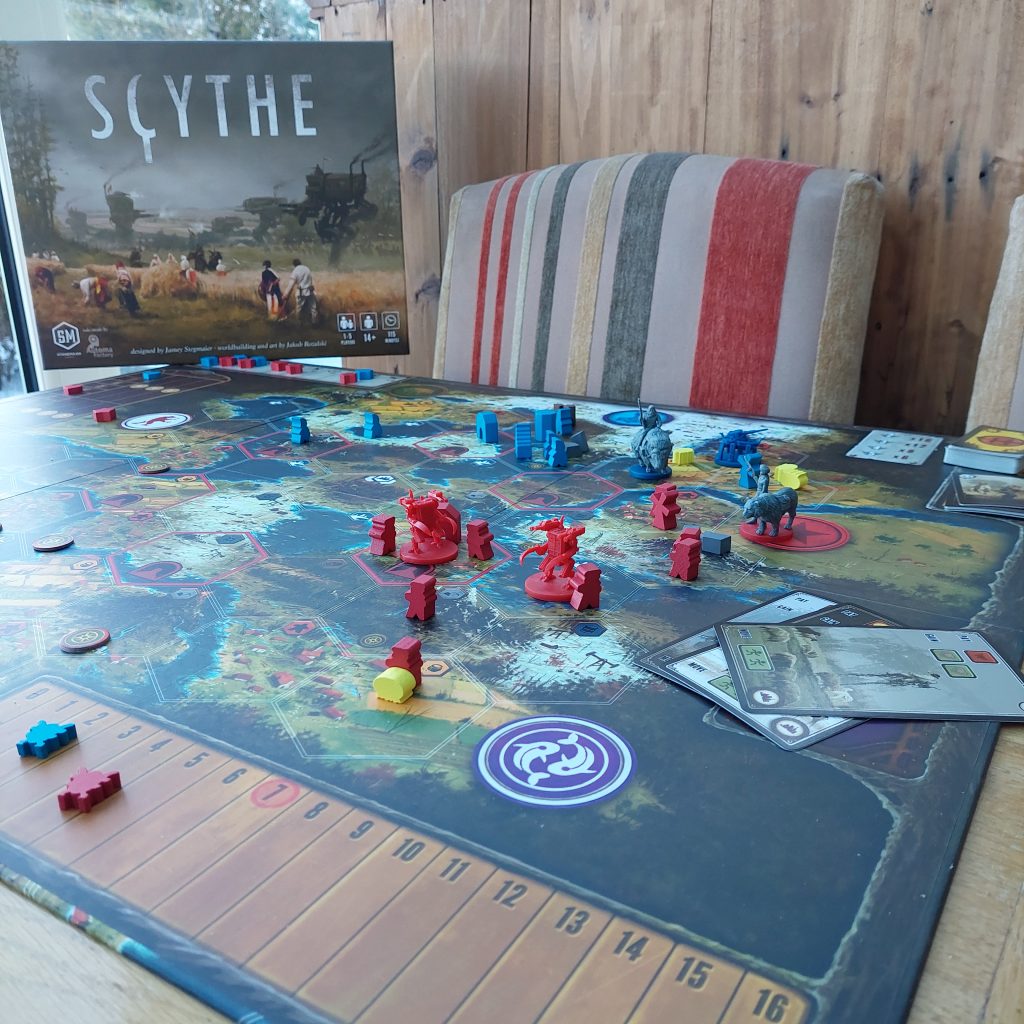
Architects of our own demise!
I know I am using “potentially” a lot but that’s for good reason. With so many choices in terms of how to propel your Faction forward, almost every action could be the best one. Or the worst one. And that’s where planning and reaction crash into each other. In our first game, I tried to plan several turns ahead, although I really had little clue as to what I could do. I based a rough strategy around resource production and adding workers in the early stages. But my opposing Faction had different ideas. I hadn’t anticipated their advances, and their land-grabbing propelled me into a place I wasn’t expecting.
This level of micro-management in the strategies you choose to implement in Scythe means that you are potentially the architect of your own success or demise. Choose the wrong focus, and you could be out-gunned, out-grown, and/or out-glorified.
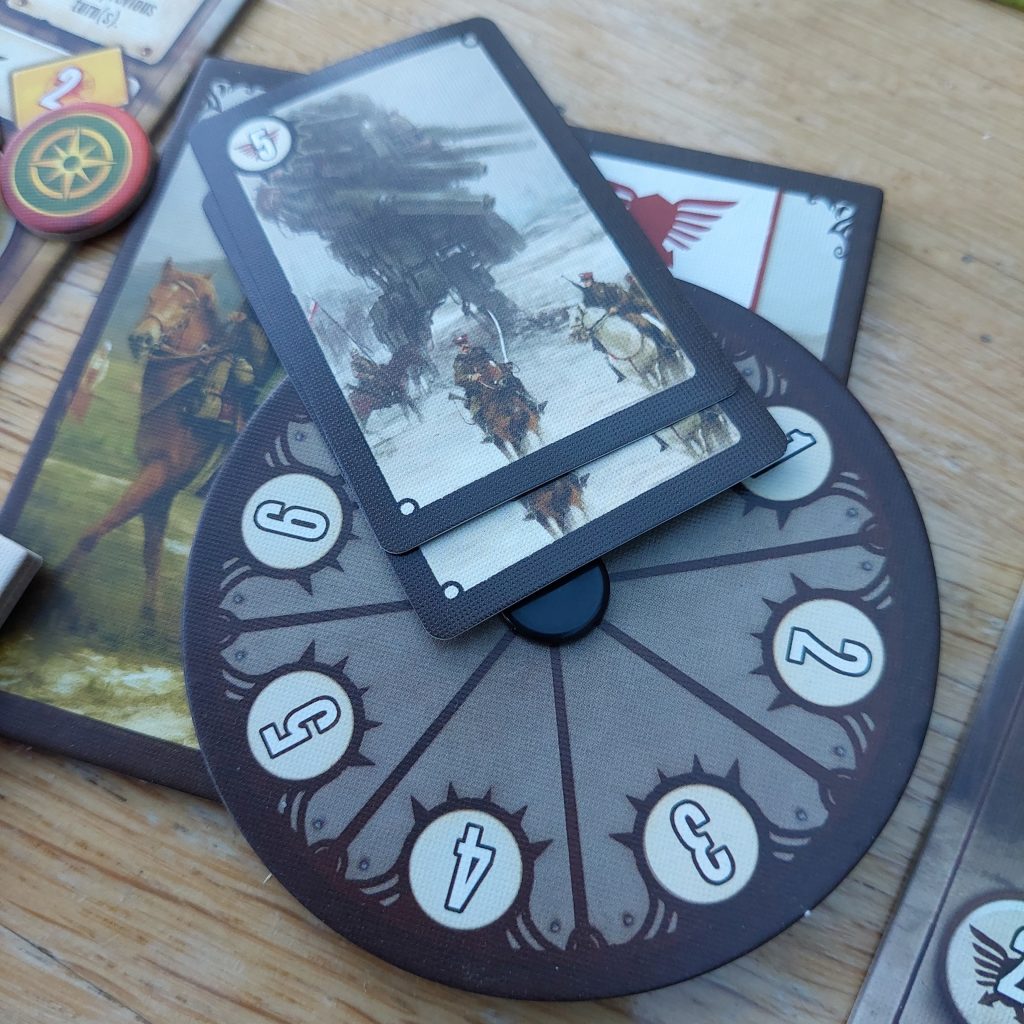
Blessed are the Peacemakers!
I don’t know whether it is a feature of 2 player games, but so far, I haven’t dwelt too much on power and combat. And, aside from that first interaction, neither has my husband. The eye-catching board is immense in both visual impact and scale. And for me, chasing about to purposefully fight him didn’t seem to be the best use of my actions or time. The combat mechanism is easy to do – you allocate strength and highest total wins. But, unless you’re gunning for a star or bonus effect based around it, the sacrifices to do it don’t really seem worth it.
Although that’s probably unfair because winning a space, explorer token, or accumulated resources from my opponent’s mini engines all have their benefits and knock-on effects. But so far, I’d rather generate good stuff on my own terms than steal it from another. And in Scythe I feel like that combat-optional slant is intentional. You should make sure you’re prepared to defend yourself– to react to someone else’s thirst for war as mentioned above – but fighting isn’t the ultimate. There are other ways for your faction to flourish. And in a way, that’s a board game acting out what we should (but often fail to) do in real life. War isn’t fantastic, and it’s usually pretty unpopular. So, I feel like it would be counter-intuitive to the objective of the game to go out looking for a fight when there is food to supply and other population pleasing actions.
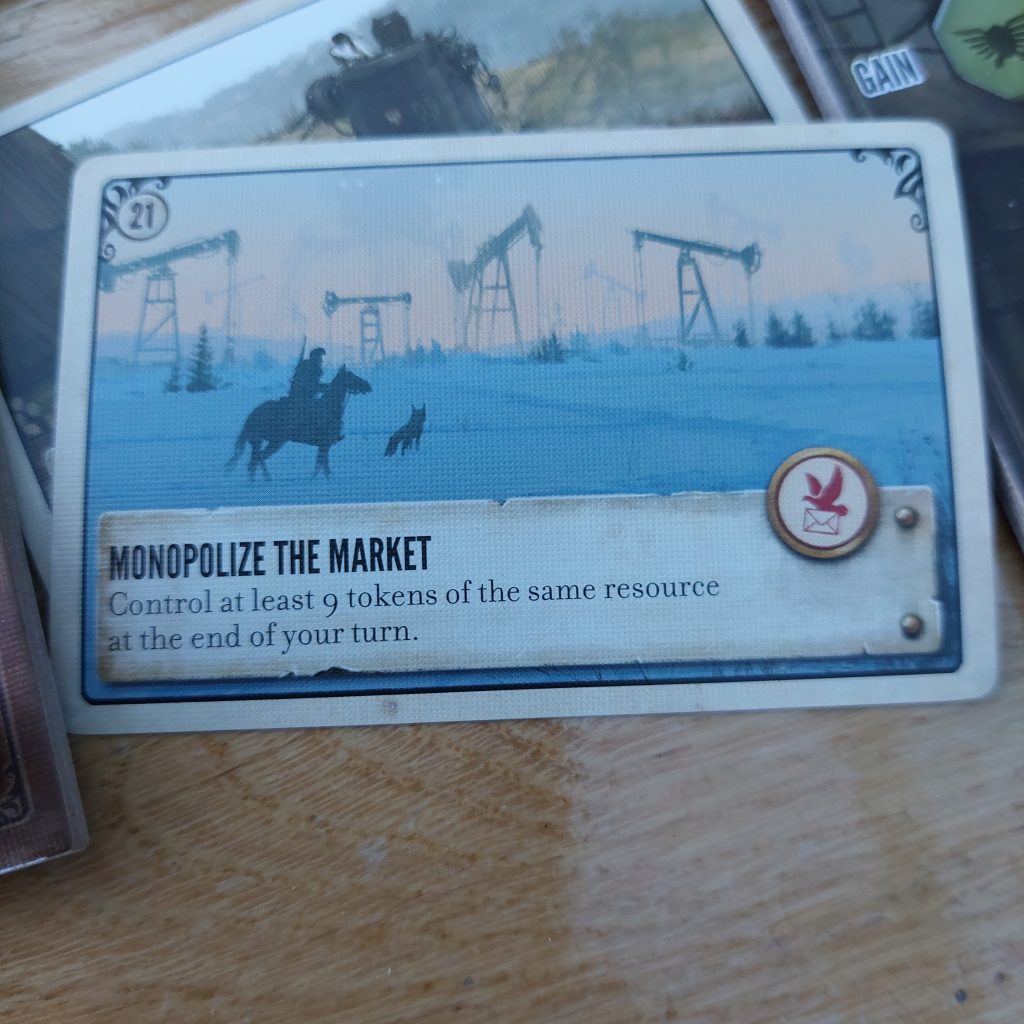
Which way?
The sheer number of different ways to approach a game of Scythe and the combination of actions and powers given to each player makes it incredibly replayable. 3 games in for us so far, and none of them have felt the same or followed the same path. Plus, there is a lot of expansion content out there now. Indeed, the reverse side of our board is one half of a much bigger arena – prepped ready for modular add-ons should we want or need a gigantic game space with even more choices and opportunities going forwards. I think we will be okay with base game for a while but it’s great to know that our game can grow with us if we want it to.
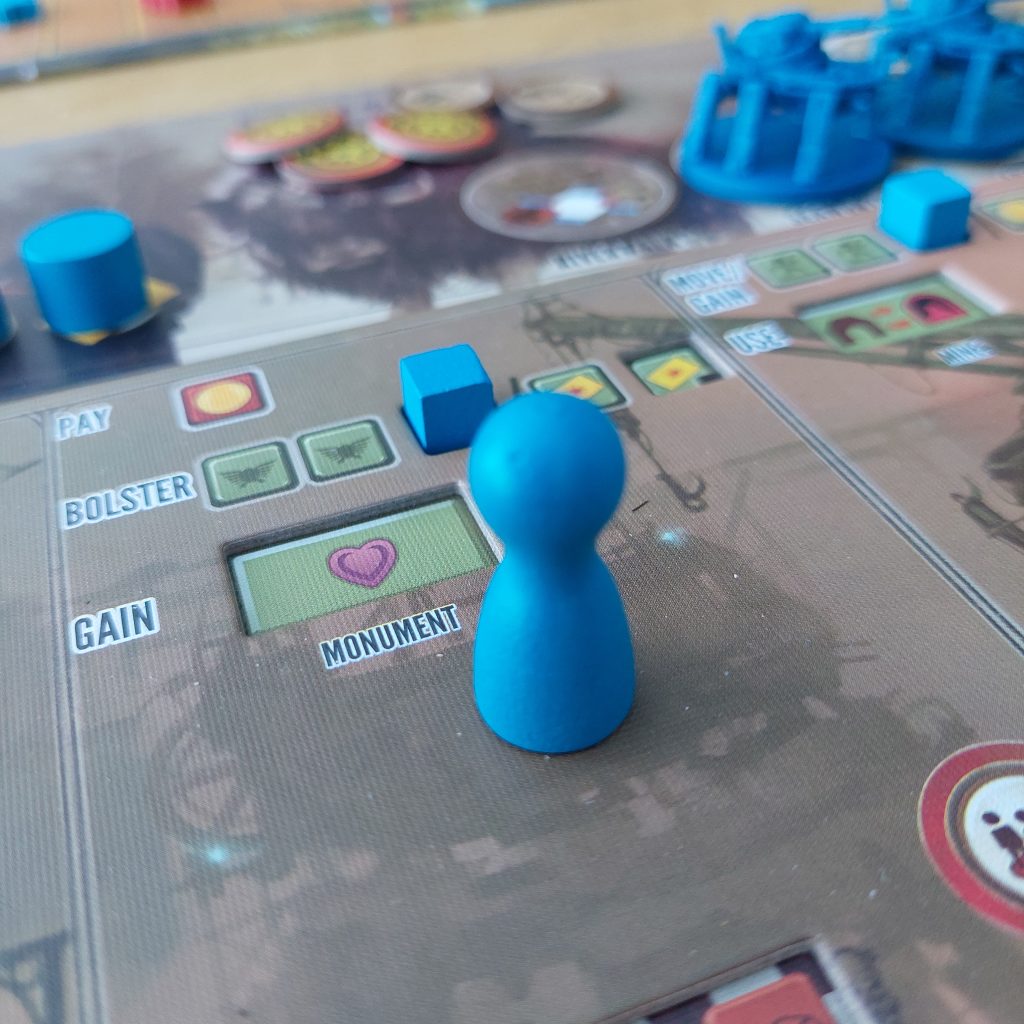
Work of art!
Speaking of the board, the components are superb. With every Stonemaier game we play, our expectations are heightened, and this game does not disappoint! There are double layered player boards, wooden tokens, minis, gorgeous cards, extensive rules, a fully fleshed Automa system, and, of course, that main board! I didn’t appreciate how much striking colour or detail was included in the illustrations and icons until we unpacked everything and saw it on our table up close. Jakub Rozalski has really bought Jamey’s design to life through his depictions of life in Europa.
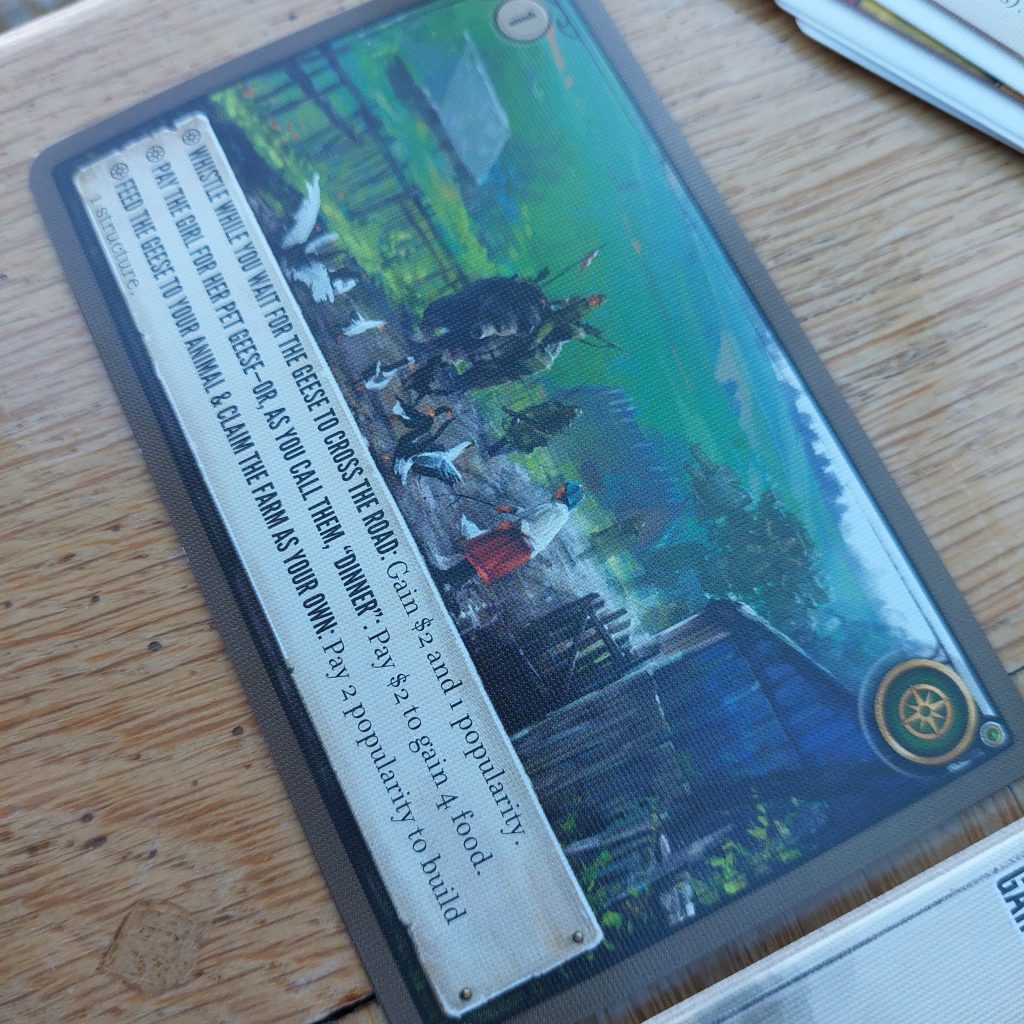
Slowly does it……
We are enjoying scratching the surface of what can be done in Scythe. And there is a lot. It’s the most expansive game we own. And so we are taking it in chunks. Not co-operatively of course. But more like giving each other the space to play out different series of actions in combination to see if they work within the space created by that specific game. This suck-and-see approach might not appeal to all. Especially gamers who prefer one clear path to victory style games. But learning by doing (and by our mistakes) seems to be the way it’s working for us. Maybe it helps that we are husband and wife – there’s no judgment as we both ultimately want to have, and want each other to have, a satisfying, enjoyable game.
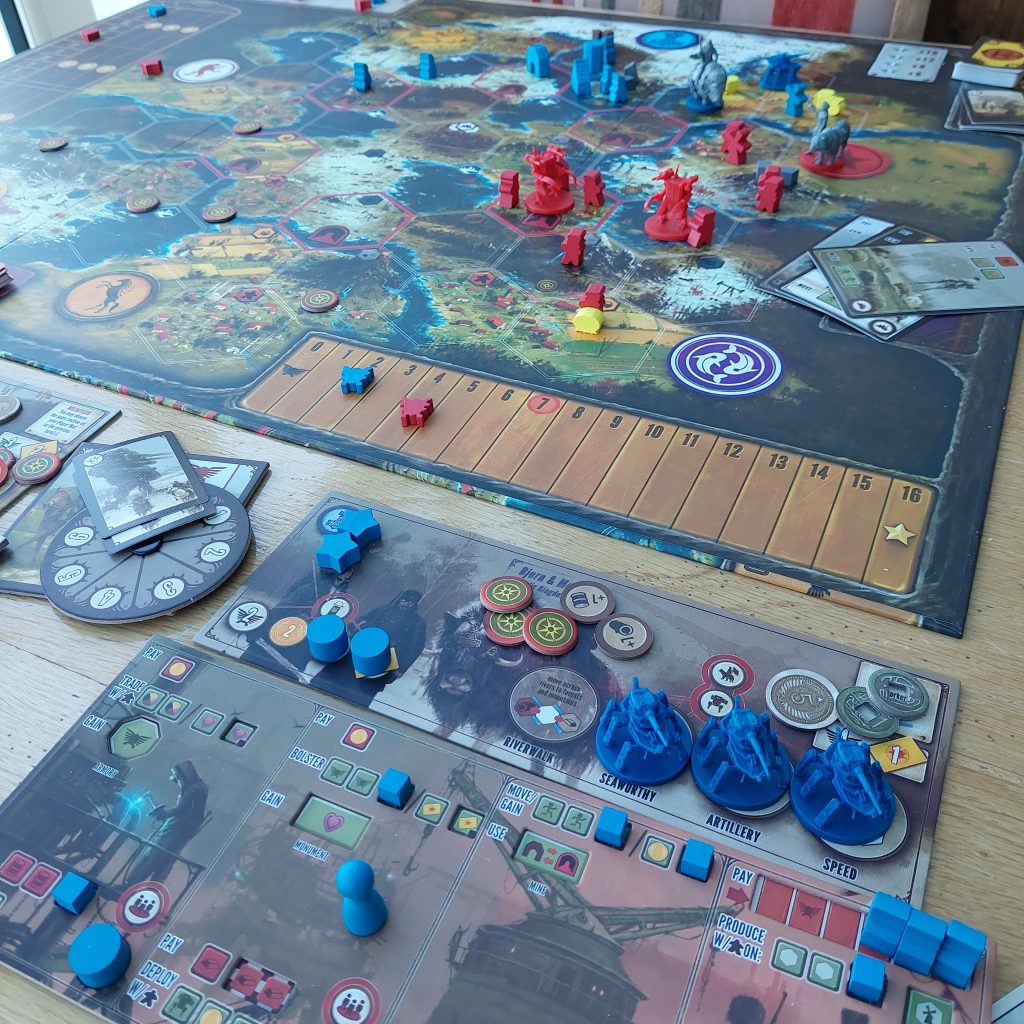
On that, we also haven’t played at more than 2 count yet, but I am hopeful that we will get to play the game at a higher player count soon. And I feel like that will be a very different, much more actively reactive experience. So, it will be really interesting to see how my current approach plays out when there are more Factions vying for (and probably fighting for) everything.
Please note that a copy of this game was kindly provided by the publishers for review. I am not paid for my comments, however, and all opinions are my own. I am also not affiliated to or sponsored by any retail store.
